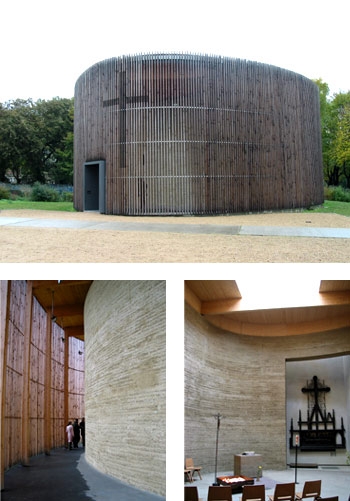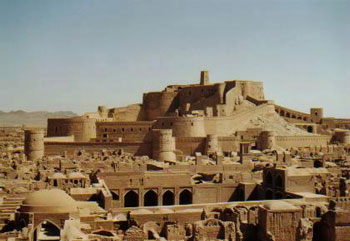Most experts are suggesting that if Bam is to be rebuilt, the mud-brick construction that made the Iranian city unique should be replaced by more modern methods. But Nader Khalili disagrees. ‘I can rebuild city with mud and barbed wire,’ says architect
The Chapel of Reconciliation

The Chapel of Reconciliation is both Germany’s first public rammed earth building in over 150 years as well as the first rammed earth German church. The building was built on the site of the former Church of Reconciliation, which was built in 1894 and was later destroyed, as it was surrounded by the wall dividing east and west Germany. The rammed earth walls in the new church are made using clay mixed with the ground up remains of the former church. The building was designed by architects Rudolf Reiterman and Peter Sassenrath and constructed with help from Austrian rammed earth expert Martin Rauch.
Niche Market
The Wall Street Journal Guide to Property thinks that Modern Mud Homes
Are a Niche Market.
La Fete de créppisage
Photo essay of La Fete de créppisage – the annual festival of plastering the great mosque in Djenne.
Plano B
Plano B is a young architecture office from Portugal interested in architecture, design and earthbuilding.
Superadobe Iran
Iranian-born architect, Nader Khalili, now working in California’s seismic zone urged his fellow Iranians to try his “superadobe” building technique, using sandbags and barbed wire, in rebuilding the 2,000 year old quake-flattened city of Bam.
Cocuy Pecayero Distillery

Among the commended entries in the ar+d 2003 architecture awards is a prototype distillery made of stabilized adobes for a small town in the impoverished semi-desert region of Venezuela. The roof is made with mud and cocuy fibre (a sort of sisal) supported by poles that bear on the mud walls. The project was designed by Rafael Mattar Neri.
Earthquake Destroys World Treasure

A devastating earthquake virtually leveled the historic heart of Bam which was one of the wonders of Iran’s cultural heritage, boasting a 2000-year-old citadel that was the largest mud-brick structure in the world. Built entirely of mud bricks, clay, straw and the trunks of palm trees, the city’s old quarter dates from pre-Islamic times, although most of the monuments were from Iran’s modern heyday under the Safavid rulers of the 16th and 17th centuries. 20,000 feared dead in the collapse of buildings in the city.
Photos of Bam pre-2003 earthquake:
Photos 1 | Photos 2 | Photos 3
Photo of Bam post-2003 earthquake:
Cornerstones Community Partnerships
Cornerstones Community Partnerships, a Santa Fe-based non-profit organization, works primarily with rural Hispanic villages and Indian Pueblos in New Mexico and the southwest to restore historic structures. It encourages traditional building techniques and works to retain cultural heritage and foster civic pride through historic preservation. For the past seventeen years, Cornerstones has assisted over 300 rural Hispanic and Native American communities throughout New Mexico, Colorado, Arizona, and Texas in the restoration of their historic and cultural structures as a means for the preservation of the rich cultural heritage unique to this region. Over 50 major restoration projects, led by the community, have been successfully completed.
United Kingdom Rammed Earth
Faculty from the Department Architecture & Civil Engineering at the University of Bath are developing rammed earth walling for UK housing construction. Their site includes a photo gallery of historic and contemporary rammed earth (and rammed chalk) projects in the United Kingdom.
